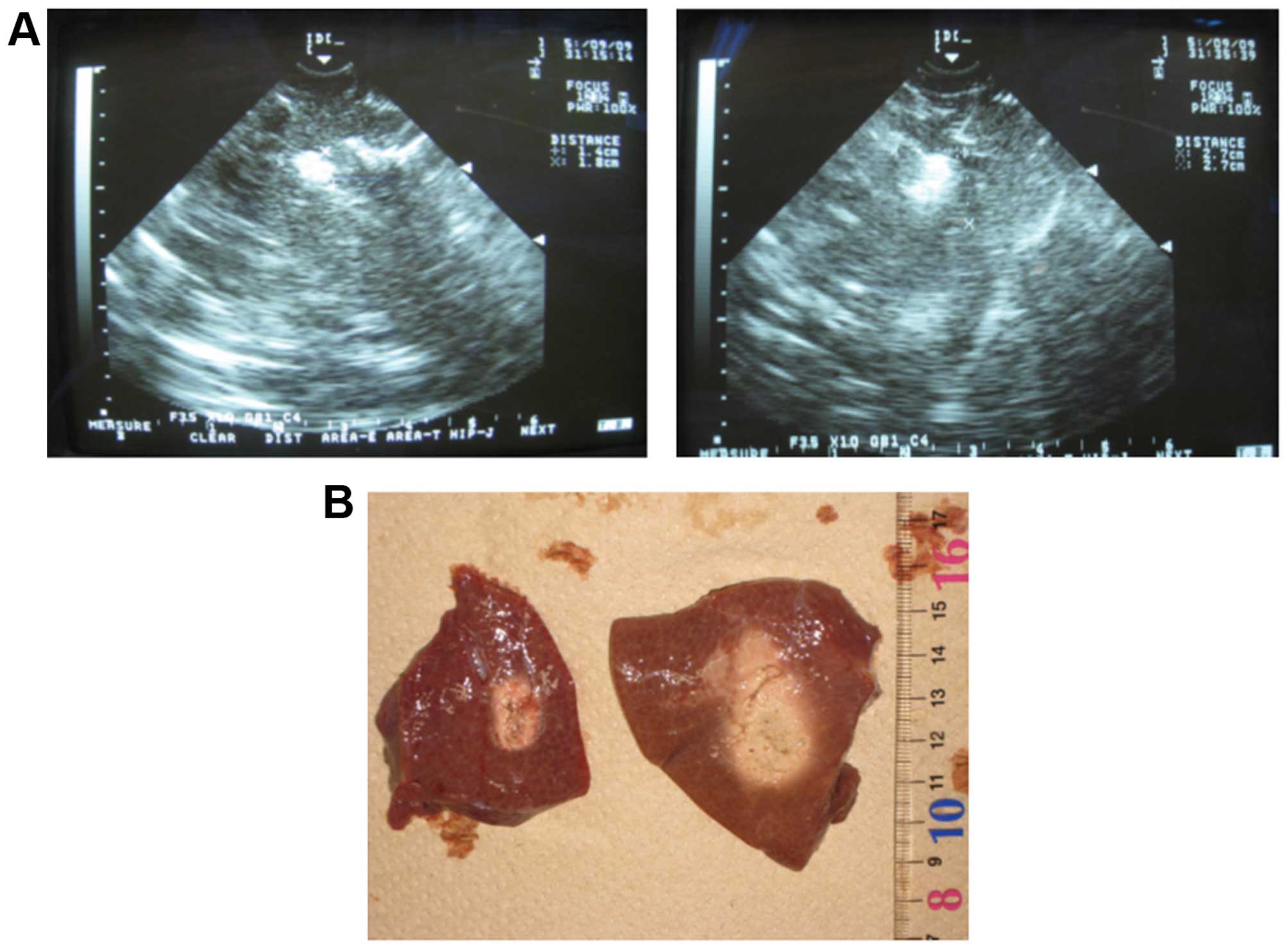|
1
|
Decadt B and Siriwardena AK:
Radiofrequency ablation of liver tumours: Systematic review. Lancet
Oncol. 5:550–560. 2004. View Article : Google Scholar : PubMed/NCBI
|
|
2
|
Solbiati L, Goldberg SN, Ierace T,
Livraghi T, Meloni F, Dellanoce M, Sironi S and Gazelle GS: Hepatic
metastases: Percutaneous radio-frequency ablation with cooled-tip
electrodes. Radiology. 205:367–373. 1997. View Article : Google Scholar : PubMed/NCBI
|
|
3
|
Solbiati L, Ierace T, Goldberg SN, Sironi
S, Livraghi T, Fiocca R, Servadio G, Rizzatto G, Mueller PR, Del
Maschio A, et al: Percutaneous US-guided radio-frequency tissue
ablation of liver metastases: Treatment and follow-up in 16
patients. Radiology. 202:195–203. 1997. View Article : Google Scholar : PubMed/NCBI
|
|
4
|
Shiina S, Tateishi R, Arano T, Uchino K,
Enooku K, Nakagawa H, Asaoka Y, Sato T, Masuzaki R, Kondo Y, et al:
Radiofrequency ablation for hepatocellular carcinoma: 10-year
outcome and prognostic factors. Am J Gastroenterol. 107:569–577.
2012. View Article : Google Scholar : PubMed/NCBI
|
|
5
|
Shiina S, Teratani T, Obi S, Sato S,
Tateishi R, Fujishima T, Ishikawa T, Koike Y, Yoshida H, Kawabe T,
et al: A randomized controlled trial of radiofrequency ablation
with ethanol injection for small hepatocellular carcinoma.
Gastroenterology. 129:122–130. 2005. View Article : Google Scholar : PubMed/NCBI
|
|
6
|
Curley SA, Izzo F, Delrio P, Ellis LM,
Granchi J, Vallone P, Fiore F, Pignata S, Daniele B and Cremona F:
Radiofrequency ablation of unresectable primary and metastatic
hepatic malignancies: Results in 123 patients. Ann Surg. 230:1–8.
1999. View Article : Google Scholar : PubMed/NCBI
|
|
7
|
Lin SM, Lin CJ, Lin CC, Hsu CW and Chen
YC: Radiofrequency ablation improves prognosis compared with
ethanol injection for hepatocellular carcinoma < or =4 cm.
Gastroenterology. 127:1714–1723. 2004. View Article : Google Scholar : PubMed/NCBI
|
|
8
|
Lencioni RA, Allgaier HP, Cioni D,
Olschewski M, Deibert P, Crocetti L, Frings H, Laubenberger J,
Zuber I, Blum HE, et al: Small hepatocellular carcinoma in
cirrhosis: Randomized comparison of radio-frequency thermal
ablation versus percutaneous ethanol injection. Radiology.
228:235–240. 2003. View Article : Google Scholar : PubMed/NCBI
|
|
9
|
Buscarini L, Buscarini E, Di Stasi M,
Quaretti P and Zangrandi A: Percutaneous radiofrequency thermal
ablation combined with transcatheter arterial embolization in the
treatment of large hepatocellular carcinoma. Ultraschall Med.
20:47–53. 1999. View Article : Google Scholar : PubMed/NCBI
|
|
10
|
Yamasaki T, Kurokawa F, Shirahashi H,
Kusano N, Hironaka K and Okita K: Percutaneous radiofrequency
ablation therapy with combined angiography and computed tomography
assistance for patients with hepatocellular carcinoma. Cancer.
91:1342–1348. 2001. View Article : Google Scholar : PubMed/NCBI
|
|
11
|
Livraghi T, Goldberg SN, Monti F, Bizzini
A, Lazzaroni S, Meloni F, Pellicanò S, Solbiati L and Gazelle GS:
Saline-enhanced radio-frequency tissue ablation in the treatment of
liver metastases. Radiology. 202:205–210. 1997. View Article : Google Scholar : PubMed/NCBI
|
|
12
|
Honda N, Guo Q, Uchida H, Ohishi H and
Hiasa Y: Percutaneous hot saline injection therapy for hepatic
tumors: An alternative to percutaneous ethanol injection therapy.
Radiology. 190:53–57. 1994. View Article : Google Scholar : PubMed/NCBI
|
|
13
|
Kurokohchi K, Watanabe S, Masaki T, Hosomi
N, Funaki T, Arima K, Yoshida S, Miyauchi Y and Kuriyama S:
Combined use of percutaneous ethanol injection and radiofrequency
ablation for the effective treatment of hepatocelluar carcinoma.
Int J Oncol. 21:841–846. 2002.PubMed/NCBI
|
|
14
|
Norlén H, Allgén LG, Bendz R and Wiklund
A: Influence of various irrigation fluids on serum enzyme patterns
following transurethral resection of the prostate. Scand J Urol
Nephrol. 20:127–136. 1986. View Article : Google Scholar : PubMed/NCBI
|
|
15
|
Norlén H, Allgén LG and Wicksell B:
Sorbitol concentrations in plasma in connection with transurethral
resection of the prostate using sorbitol solution as an irrigating
fluid. Scand J Urol Nephrol. 20:9–17. 1986. View Article : Google Scholar : PubMed/NCBI
|
|
16
|
Goldberg SN, Gazelle GS, Compton CC,
Mueller PR and Tanabe KK: Treatment of intrahepatic malignancy with
radiofrequency ablation: Radiologic-pathologic correlation. Cancer.
88:2452–2463. 2000. View Article : Google Scholar : PubMed/NCBI
|
|
17
|
Jiang HC, Liu LX, Piao DX, Xu J, Zheng M,
Zhu AL, Qi SY, Zhang WH and Wu LF: Clinical short-term results of
radiofrequency ablation in liver cancers. World J Gastroenterol.
8:624–630. 2002. View Article : Google Scholar : PubMed/NCBI
|
|
18
|
Kitamoto M, Imagawa M, Yamada H, Watanabe
C, Sumioka M, Satoh O, Shimamoto M, Kodama M, Kimura S, Kishimoto
K, et al: Radiofrequency ablation in the treatment of small
hepatocellular carcinomas: Comparison of the radiofrequency effect
with and without chemoembolization. AJR Am J Roentgenol.
181:997–1003. 2003. View Article : Google Scholar : PubMed/NCBI
|
|
19
|
Kurokohchi K, Watanabe S, Masaki T, Hosomi
N, Miyauchi Y, Himoto T, Kimura Y, Nakai S, Deguchi A, Yoneyama H,
et al: Comparison between combination therapy of percutaneous
ethanol injection and radiofrequency ablation and radiofrequency
ablation alone for patients with hepatocellular carcinoma. World J
Gastroenterol. 11:1426–1432. 2005. View Article : Google Scholar : PubMed/NCBI
|















